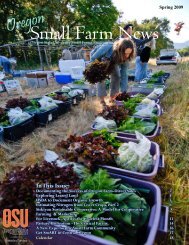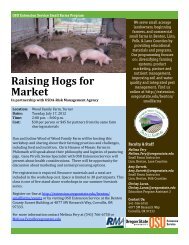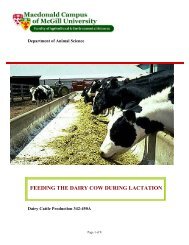Small Farm News - Oregon Small Farms - Oregon State University
Small Farm News - Oregon Small Farms - Oregon State University
Small Farm News - Oregon Small Farms - Oregon State University
You also want an ePaper? Increase the reach of your titles
YUMPU automatically turns print PDFs into web optimized ePapers that Google loves.
contain one of the herbicides of concern. Manures<br />
that contain these herbicides can be safely spread on<br />
grass pastures or grass hayfields. Note: It takes 4 to 7<br />
days for most animals’ digestive tracts to clear and the<br />
manure produced to be free of any herbicide residue.<br />
<strong>Farm</strong>ers and Gardeners Wanting to Use Manure or<br />
Compost<br />
Before acquiring or using manure – fresh, aged, or<br />
composted – ask what the animals were fed, the origin<br />
of the hay, and what, if any, herbicides were used on<br />
the hay or pasture. Some livestock owners can tell you<br />
this, but many might not know the products used or<br />
origin of the hay they purchased. They may suggest the<br />
manure is “safe” because their animals have not been<br />
affected. If you don’t know which, if any, herbicides<br />
were used, use the bioassay described below to test<br />
for the presence of these herbicides. Do not use the<br />
manure or compost to grow sensitive crops without<br />
knowing its herbicide history or testing to see that it<br />
is safe. If you find yourself with a small quantity of<br />
contaminated manure or compost, spread it on a grass<br />
pasture, grass hayfield, or non-sensitive, nonfood crop<br />
area.<br />
Great care should be taken in using contaminated<br />
manure or compost to grow commercial food crops.<br />
Consult the herbicide product label to determine if<br />
the pesticide is labeled for use (legally permitted to<br />
be applied) to that crop. If the product has already<br />
been applied to the soil, tilling it several times during<br />
the growing season, irrigating the area, and planting<br />
it into a non-sensitive cover crop for a year or two<br />
will help the herbicides break down. Conduct a pot or<br />
field bioassay, as described below, before planting any<br />
sensitive crops in the area.<br />
<strong>Farm</strong>ers and Gardeners<br />
Wanting to Use Hay or<br />
Grass Clippings<br />
If you want to use hay or<br />
grass clippings as mulch<br />
or in your compost pile,<br />
find out what, if any,<br />
herbicides were used<br />
on the field or lawn.<br />
Be particularly careful<br />
about obtaining grass clippings from golf courses and<br />
other commercial turf fields where these herbicides<br />
are commonly used. Most homeowners do not use<br />
these herbicides because they are not labeled for<br />
use on residential lawns. If you find yourself with<br />
contaminated hay or grass clippings, spread them<br />
on non-sensitive, nonfood crop areas, burn them, or<br />
arrange to have them disposed of safely. If the hay<br />
or grass clippings have already been applied to the<br />
field or garden, remove them, till the soil, sow a nonsensitive<br />
cover crop, and let it grow for a year or two<br />
to help the herbicide break down. Conduct a pot or<br />
field bioassay, as described below, before planting any<br />
sensitive crops in the area.<br />
How to Test for the Presence of Herbicides: Pot and<br />
Field Bioassays<br />
Some laboratories can test for the presence of these<br />
herbicides, but the tests are expensive and not as<br />
sensitive as a plant bioassay that you can perform<br />
yourself. This simple pot bioassay involves growing<br />
beans or peas, which are very sensitive to the presence<br />
of these herbicides, in the manure or compost. First,<br />
take a number of random, representative samples<br />
(small shovelfuls) from throughout the pile of manure<br />
or compost, being sure to get deep inside the pile. Mix<br />
thoroughly. If there are separate sources of manure or<br />
compost, conduct individual assays for each. Prepare<br />
3 to 6 small (4- to 5-inch) pots with a 2:1 mix of the<br />
manure or compost and a commercial potting mix<br />
with fertilizer. Fill several control pots with only the<br />
commercial potting mix. Put saucers underneath each<br />
pot, or position the pots far enough apart so that water<br />
running out of the bottom of the pots will not reach<br />
another pot. Plant three pea or bean seeds in each pot,<br />
water, and let them grow for two to three weeks, until<br />
there are three sets of true leaves.<br />
If the peas or beans in the control<br />
pots grow normally and the ones in<br />
the pots with manure or compost<br />
do not, you can assume the manure<br />
or compost is contaminated with<br />
an herbicide which will adversely<br />
affect sensitive plants. If they<br />
all grow normally, it would be<br />
reasonable to assume that the<br />
manure or compost is fine. Keep<br />
<strong>Oregon</strong> <strong>Small</strong> <strong>Farm</strong> <strong>News</strong> Vol. IV No. 3 Page 20















